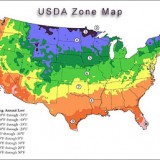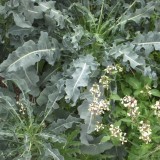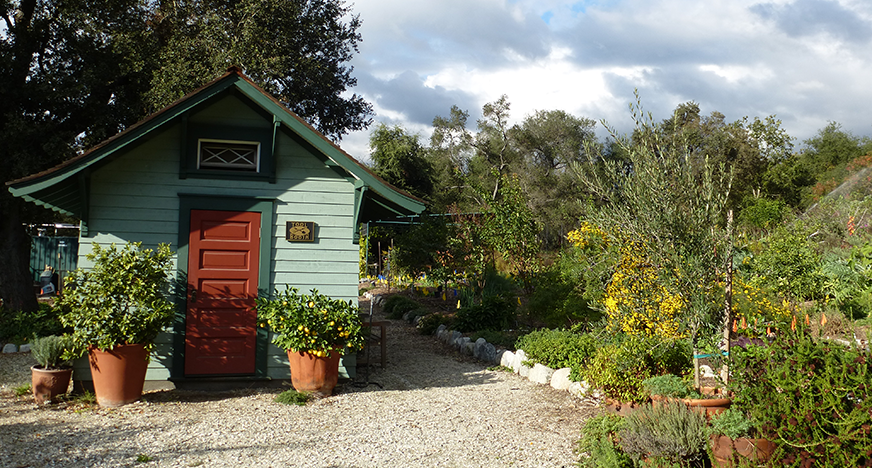 It’s about damn time we gave an overall tour of the Homegrown Evolution digs, at least to dispel some misconceptions out there (more on those at the end of the post). Let’s begin with the front yard, pictured above.
It’s about damn time we gave an overall tour of the Homegrown Evolution digs, at least to dispel some misconceptions out there (more on those at the end of the post). Let’s begin with the front yard, pictured above.
Our house sits up about 30 steps from the street level. Running the laundry water out to the front (using Oasis Biocompatible Detergent), has really made the plants happy. The front yard has a mix of prickly pear cactus, Mexican sage, wormwood, rosemary, lavender, California poppies, and nasturtiums. All low maintenance, drought tolerant, hardy stuff. At the top, not visible in the photo, are the fruit trees we planted and described in an earlier post. Due to extensive foundation work (note to potential home buyers: don’t buy a house on a hill!) we’ve only recently been able to work on the top part of the front yard.
 Next the backyard, pictured above (click to bigulate). The extreme wide angle makes it look a lot bigger than it actually is. In reality, the backyard is about 35 feet by 50 feet. Starting on the left and moving right, is an arbor occupying the former space of a terrible add-on that we demolished (and carried down the stairs by hand–once again, don’t buy a house on a hill!). In the background is the chicken coop and run, with the herb garden in the foreground. Just to the right of the chicken run are several large artichoke plants. Behind that and out of sight, is a 4′ x 8′ raised bed for vegetables. Next to the shed is a small orange tree, just planted, that replaced the fig tree we tore out. Dominating the right side of the photo is the avocado tree. Next to that tree is a small dwarf pomegranate, and on the extreme right is another raised bed with strawberries, garlic, mint and a native grape vine, just about to leaf out.
Next the backyard, pictured above (click to bigulate). The extreme wide angle makes it look a lot bigger than it actually is. In reality, the backyard is about 35 feet by 50 feet. Starting on the left and moving right, is an arbor occupying the former space of a terrible add-on that we demolished (and carried down the stairs by hand–once again, don’t buy a house on a hill!). In the background is the chicken coop and run, with the herb garden in the foreground. Just to the right of the chicken run are several large artichoke plants. Behind that and out of sight, is a 4′ x 8′ raised bed for vegetables. Next to the shed is a small orange tree, just planted, that replaced the fig tree we tore out. Dominating the right side of the photo is the avocado tree. Next to that tree is a small dwarf pomegranate, and on the extreme right is another raised bed with strawberries, garlic, mint and a native grape vine, just about to leaf out.
Now to correct some misconceptions:
Our place looks like Versailles. Truth is, at some times, our garden looks terrible. It depends on the season, and the amount of time we have to put into it. It looks good now, but in December it looked like crap. We try to plant things that do well in our climate and provide food, medicine or habitat for birds and beneficial insects. But we’ve made plenty of mistakes, and continue to do so.
We’re survivalists. Can we live off our yard? No. Can we make a meal with stuff from the yard? Yes, but we go to the supermarket just like everybody else–there’s no room for a wheat field after all, nor do we grow coffee or a host of other necessary staples. But, we seldom buy greens at the store, and almost never buy herbs or eggs–we’ve got that taken care of in the garden. In the summer we have lots of tomatoes, and right now we have a few avocados. When the fruit trees mature in a few years we’ll have fruit.
We’re hippies. Don’t get us wrong, we love hippies. We have no problems with cob ovens shaped like psychedelic snails, but that just ain’t our style. We’ve tried to keep things low key, just like our humble 1920s bungalow. This grape vine trailing up the arbor we built sums up our visual style:
 Lastly, we like to tuck in a few attractive edibles (packed tightly, as you can see) wherever we can, like this magnificent cabbage, so beautiful we hate to harvest it:
Lastly, we like to tuck in a few attractive edibles (packed tightly, as you can see) wherever we can, like this magnificent cabbage, so beautiful we hate to harvest it:







Wow. As modest you are about it, I am jealous!
Beautiful! It’s not Zen or Dutch or even tidy English, but then, who really cares about that, anyway? I would gladly be your neighbor. And steal your fruit.
Mrs. Homegrown here, with a few comments.
1)I am appalled that Mr. Homegrown has sent a tour of our yard out through the worldwide internet tubes without letting me straighten up first. The chicken coop isn’t always covered with dangling bits of blue tarp, and the crap in front of the coop has to do with an isolated chicken. Long story.
2) Yes, the truth is out: we don’t live in the spectacular modernist palace depicted on the book cover. In addition, I also lack the goth je ne sais qua of my sultry doppleganger.
3) We *never* buy eggs or herbs. I don’t know what he’s talking about with “rarely” — we’re up to our ears in eggs. Please come by and get some.
4) While you’re at it, take some nopalitos, too.
5) He skipped showing you the parkway garden beds, which contribute greatly to our table.
6) Those of you living in normal climates might be wondering at his statement that our garden looked bad in December. After all, in temperate climates, every garden looks bad in December–if you can see them at all beneath the snow.
Here in sunny LA, though, it hovers around 70 in December, so it seems as though there’s no excuse for a dead garden. That’s what he means. But our garden is exhausted from the long summer without a lot of supplemental irrigation. Our summer ends in late October, and the perennials and self-seeding annuals that dominate our landscape don’t spring to life until March, after the rains.
Winter is a great time to grow salad stuff in LA, though. Just fyi for any So Cal people who might be reading.
7) Did I already offer nopalitos to all comers?
Hello! I was wondering if you knew of a good site or book on how one could put together a slow drip irrigation system for raised beds. Thanks!
MM
Taproots,
I got a Sunset book out of the library – it wasn’t about raised beds specifically, but it worked. Do you have a good nursery nearby? If so, someone there should be able to help you put together the right components. It’s not that complicated, especially for a raised bed.
We’ll post on the subject soon as Mrs. Homegrown has some objections to the way I’ve put our system together.
Good Luck!
Erik
This is a GREAT blog! I love the Bicycle ride through those crazy freeways! I’m a local too (91745) so I know how jam-packed those things get. I JUST started on my journey to become more self-sufficient. Nice to have a “neighbor”!
[29 May 2008, in the USA (annoying of this site to omit dates)]
mrs/ms homegrown looks all right to me. (and there were some goths how did their hair in a kind of pseudo-30’s style.)
houses on hills are stable when on rocky outcrops (which are rare on flat land). at least you weren’t carrying new materials uphill/stairs. (you may have been able to slide or chute the bust n stuff down, btw)
i hope there’s no lead paint on that grape column. outdoors, wood is a short term material, btw.
wouldn’t a little irrigation thru fall (or just starter irrig.) pay off with months of cool season growth?